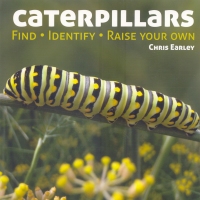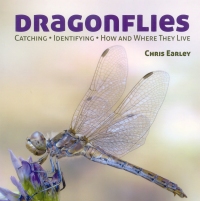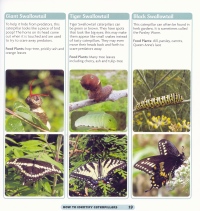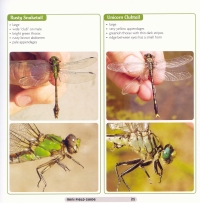| ________________
CM . . .
. Volume XIX Number 39. . . .June 7, 2013
excerpt:
If these two books were to be found on a restaurant’s menu, they would both be listed under the “appetizer” section. Brief, but quite “tasty”, they are guaranteed to whet youngsters’ appetites and make them want to get to the main course - actually finding caterpillars or dragonflies.
Most people have witnessed butterflies and moths fluttering about, but likely only the more observant have ever seen caterpillars, and, even when they have, they might have just considered them to be some sort of “worm”. With Caterpillars: Find, Identify, Raise Your Own, author Chris Earley hopes that these finders of “worms” will be able to move to the next stage, that of knowing what kind of butterfly or moth that caterpillar will eventually become. Earley’s brief text takes readers through defining what a caterpillar is, including its parts, before moving on to its life cycle of egg, caterpillar, chrysalis or cocoon, and adult. He also provides responsible advice on how the book’s readers can find and “raise” a caterpillar. Each of these sections is well-illustrated with colour photos.
The book’s final pages are essentially given over to a section labeled “How To Identify Caterpillars”. According to Earley:
In the 14 pages in this section, readers encounter the caterpillars of 38 butterflies or moths. The entry for the Black Swallowtail, which is accompanied by photos of the Black Swallowtail in its caterpillar and adult stages, is typical of the information that is provided for each caterpillar.
On the book’s penultimate page, there a briefly annotated bibliography, “Books About Caterpillars”, that lists three field guides to caterpillars and a book of fiction. An index completes the work. Dragonflies, nature’s “helicopters” which dart about, are also something that most of us have observed. Unlike butterflies and moths whose colours indicate that they are different species, to the untrained eye, most dragonflies look very similar, and their differences in size we might erroneously attribute to stages of maturation. Earley begins Dragonflies: Catching, Identifying, How and Where They Live by distinguishing between dragonflies and their closest relative, damselflies. The latter are a lot skinnier and smaller than most dragonflies. As well, “dragonflies hold their wings out beside their body, while damselflies hold their wings together and above their body.” Despite their resemblance, Earley makes it clear that “we will concentrate on dragonflies in this book.” As in the caterpillar book, Early also presents this insect’s life cycle which consists of three stages: egg, nymph and adult. While Caterpillars discussed catching and “raising” caterpillars, the dragonfly is the adult stage, and, consequently, Earley describes a catch and release approach. A pair of facing pages are given over to describing six common dragonfly families: Darners, Clubtails, Spiketails, Cruisers, Emeralds and Skimmers. “These are the kinds of dragonflies that you are most likely to find in North America.” Seventeen pages then constitute a “Mini Field Guide” that features a single Spiketail, eight Darners, four Clubtails, four Emeralds, 16 Skimmers and a single Cruiser. Each entry provides two photos of the dragonfly, with one being a “portrait” of the dragonfly while the second one usually focuses on some distinguishing feature of that particular dragonfly. The brief text accompanying each dragonfly simply provides identifying characteristics. For example, that accompanying the Swamp Darner says:
Immediately preceding the book’s closing index is “Books about Dragonflies” in which Earley briefly introduces five more advanced books about dragonflies. While both books have tables of contents, given the books’ brevity, this feature was really not necessary, especially when the headings are inconsistent. The excerpt above, taken from Caterpillars: Find, Identify, Raise Your Own, merited its own entry in the “Contents” despite its very short length. However, six pages describing the four stages of a butterfly or moth’s life cycle were subsumed under the single heading of “Life Cycle” in the table of contents. Another small shortcoming of both books is that Earley does not indicate the geographic range of the book’s caterpillars/butterflies/moths and dragonflies. Nonetheless, as I said at the outset, both books are appetizers, and in that role they succeed admirably. Recommended. Dave Jenkinson, CM’s editor, lives in Winnipeg, MB.
To comment
on this title or this review, send mail to cm@umanitoba.ca.
Copyright © the Manitoba Library Association. Reproduction for personal
use is permitted only if this copyright notice is maintained. Any
other reproduction is prohibited without permission.
NEXT REVIEW |
TABLE OF CONTENTS FOR THIS ISSUE
- June 7, 2013.
AUTHORS |
TITLES |
MEDIA REVIEWS |
PROFILES |
BACK ISSUES |
SEARCH |
CMARCHIVE |
HOME |



 One of the two accompanying photos provides a closeup of the Swamp Darner’s blue eyes.
One of the two accompanying photos provides a closeup of the Swamp Darner’s blue eyes.